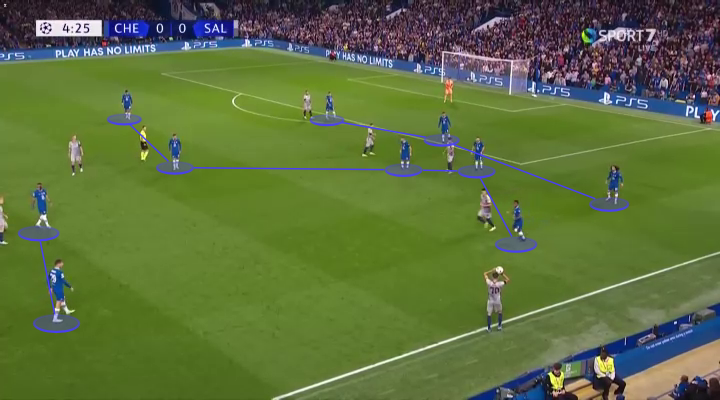In my entire existence on this website, I have never received so many questions about the same topic in a span of less than twenty-four hours. What, on earth, were Chelsea doing on Wednesday? What formation were they playing? What was Sterling? What was Cucurella? How did it all come together in such strange fashion? I’m paraphrasing, of course. But the point stands; and it’s a question that arises once again from Potter’s incessant desire to be very fun.
Embed from Getty ImagesThe key to studying formational aspects and player positioning is in watching one team over the course of the match, and focusing your attention away from the ball. After completing this conquest, let me tell you, definitively, that Chelsea were playing one of the most unique formations I’ve ever seen. In practice, it worked almost like a 3-1-6. Sounds fun, doesn’t it? Very Potter-esque, after all. In reality, we can best describe their formation throughout the phases of the game as a 3-5-2. Let me break it down by hitting you with some quick facts.
Embed from Getty Images- Reece James never engaged in the same line height as the other defenders out of possession. He only moved into a right-back position when responding to an advancing run of an opponent. So he cannot be assumed to have been playing as part of a back-four.

In possession, it’s obvious to say that he was a right-wing-back. Out of possession, it’s also obvious to say that he was a right-wing-back, even by Jon Mackenzie’s understanding of the word “obviously”. But obviously, Mason Mount also covered the same spaces on occasion, which elucidates James’s high positioning all the more.
I’d hazard to guess that James’s heatmap only spiked red on those lower sections of the pitch after he moved into the role of a right-centre-back, when Hakim Ziyech took over his position up and down the right wing.

Here we see a nice example of the 3-5-2 come to life, albeit off a defensive throw. This leads me into the next point…
- Raheem Sterling played almost strictly out wide, and more in line with James in Chelsea’s half, than in line with Havertz and Aubameyang.

- Mason Mount engaged in the same line height as Mateo Kovacic, with the Croatian more likely to drop-in during the build-up to progression.

- Kai Havertz topped a midfield diamond in deeper phases of possession, but held a clearly defined role up top *alongside* Aubameyang further up the field. You could therefore call this 3-5-1-1, which we know Potter loves. But Havertz’s high role in attack means 3-5-2 (or the outrageous 3-1-6) is actually more likely.
Our friends over at WhoScored? agree. Here you can see the type of 3-1-6 we describe, with the only caveat being James’s slightly lower position than Sterling. This caveat might even be easily explained in one simple sentence. Chelsea attacked down the left less, meaning Sterling could hold his high and wide stance for longer periods of time.

So definitively, let me be the first (or maybe the tenth) to dispel the myth that Chelsea played in a back-four on Wednesday. And while it’s true that Mount operated in the right-half-spaces, it’s also true of Mateo Kovacic made as many equally valuable bursting runs forward on and off-the-ball.

That means a midfield three is far more likely than a midfield two. That midfield three works incredibly well, and actually did work incredibly well in Frank Lampard’s short time at the helm. Jorginho provides holding support to allow Kovacic and Mount to rummage forward as they please, accomplishing different feats of awesomeness in attack. One is more progressive in carrying and dribbling; the other more instinctive in chance creation. Without that added component of the Italian, the other two would simply be more restricted in their role.
Embed from Getty ImagesOn that note, it’s worth noting the excellent understanding between Sterling and Kovacic down the left, and Mount with James down the right. These are partnerships that Graham Potter can build upon at Stamford Bridge, with one member of each pairing clearly excellent at playing passes in behind (Sterling and Mount) for the other to run onto (Kovacic and James). The energetic combination of Mount and James even worked wonders in the opening goal, to which Sterling ultimately finished off.
Embed from Getty ImagesWhen you add in the outside-centre-backs to compound the overload, you may start to garner a recipe for greater attacking success.

That brings us to the next point, and perhaps the point of all points when it came to establishing Chelsea’s system of play. Cucurella and Azpilicueta held the same role – galloping up the field to overlap and underlap in the wide areas, when they weren’t supporting the progression of play from the same line height of Jorginho (like Inverted Fullbacks). Above anything else, that is a clear indication that the team were playing in a back-three, rather than any other weirdness you may assume.

I usually don’t display my articles in list format, but the structure of this has already been thrown out the window. So let’s explore a few other key intricacies of note as Potter learns his players and ingrains his tactics into the team.
OTHER KEY INTRICACIES
Embed from Getty Images- Jorginho supported the build-up in a diamond quartet alongside Kepa, with Kovacic more likely to drop into left-half-spaces to pick up possession than Mason Mount. When Thiago Silva also dropped into Kepa’s line height, it became more like a 2+3 build-up, just with extra fancy sauce.

- At the other end of the pitch, Chelsea’s press shaped up to be a 3-2-3-2. The full camera angle never quite captured this (except as the ball travelled over top of the first couple of lines).

In these cases, Mount pushed up on Salzburg’s single pivot, as more of that ‘number ten’. Sterling and James again enacted that same line height, as the back-three held compactness with the midfield two to win long passes. Salzburg were then often forced into going long from Chelsea’s pressing positioning, which allowed the Blues to easily regain possession and go again.
Embed from Getty ImagesQuite evidently though, it’s not the Blues’ defense that they need to work on in greater detail. It’s their attack. That’s because…
- Aubameyang presented (and presents) a serious conundrum for Graham Potter. He’s not the ‘Channel Running’ striker of a Neal Maupay or Danny Welbeck, or at least, he’s not anymore. Quite frankly, he’s lazy, static and uninvolved throughout the phases of play. He may pop up in nice spaces of attack to finish off moves, but Sterling could do the same, while remaining more engaged throughout the phases.
Armando Broja is more the type to run the channels and use his energy for the betterment of the team, which immediately came to life upon his introduction into the game. Rapid on the break, Broja looked lively in that centre-forward role, and could be someone Potter relies on to bring greater attacking thrust from the bench in the coming weeks.
Embed from Getty ImagesBut at the very least, it was nice of Aubameyang to warrant my attention. Kai Havertz had the more difficult night of the two, as his slightly deeper position sometimes meant he was bypassed completely in Chelsea’s route from out wide to Aubameyang.

With some of these aspects working in tandem, Chelsea continued to struggle in their quest to break down a compact defense through the centre of the pitch. BUT their attempts to throw Cucurella and Azpilicueta forward into the attack had the potential to cause chaos. Another opposition club will exploit this by leaving more numbers in attack, and outnumbering the odd rest-defense of 1+1 with a ‘Sweeper Keeper’ in behind. But it worked in the context of the match, with Salzburg sitting deep and absorbing pressure.

All matches are open to interpretation and viewpoints about player positioning can be subjective. But with the eye test and heat/touch-maps agreeing that the formation worked more like a back-three than a back-four, it’s strange to see debate over something that might not be as complex as it’s made out to be. Chelsea played in a 3-5-2, and one that never needed to become a back-five in defense.
Embed from Getty ImagesSterling’s role as a wing-back likely won’t continue for much longer (at least, we hope so), but the refusal to accept him in the position stems from the absurdity of it all more than the reality of it all. Formations aren’t pointless, by the way. Without one, the basic principles that allowed the likes of Cucurella, Azpilicueta and Kovacic to enact and inject variety would have been lost.
Embed from Getty ImagesThey act as a nice starting place for players to make a role their own, and even then, Aubameyang just isn’t going to touch the ball no matter what you do. But a 3-1-6 is not a departure from Graham Potter’s principles at Brighton, and the attacking fluidity by which he built his success around with the Seagulls. How he adapts and changes Chelsea’s fortunes around remains to be seen, but hopefully this has provided you with an answer.
Embed from Getty Images
So there it is! The answer to the question that you’ve all been asking. Here’s to Potter’s first match at Stamford Bridge. We look forward to many more fun nights with him at the helm. Thanks for reading and see you soon!
YOU MIGHT ALSO ENJOY…
Game of Numbers #27 – Heung Min-Son as the ‘9’ & Evan Ferguson’s hat-trick
In spite of Tottenham’s formidable, unbeaten start to the season, something felt missing without the presence of a goal-scoring ‘#9’ up front. It may have been the obvious move with Richarlison not exactly hitting the ground running, but Ange Postecoglou might just have found the perfect solution in Heung-Min Son. Here is Game of Numbers…
Game of Numbers #26 – James Ward-Prowse & West Ham on the break
Despite Brighton’s high-flying start to the season, I worried about what would happen when faced with a truly great counter-attacking side, given the space out wide in their shape. Well, in came West Ham United, one of the best counter-attacking teams in the world. Here is Game of Numbers #26, starting with how West Ham…
Why Alexis Mac Allister is perfect for Liverpool
Hands down, Alexis Mac Allister has been one of the Premier League’s most improved players from this season to last. For his seamless transition into a ‘DLP’ role at Brighton, where he played a critical role in the team’s sixth place success, I even had the Argentinean midfielder in my ‘Team of the Season’. To…
Game of Numbers #19 – How to cross like Pervis Estupiñán
Crucially for his role as a ‘Wing-Back’, Pervis Estupiñán is one of the best crossers of the ball in the division. That has translated in over 3 crosses and 1.6 key passes per 90 in league play. It’s the awareness of when to keep the ball on the grass or when to raise the ball…






2 thoughts on “Potter’s first match at Chelsea – Tactical Analysis”